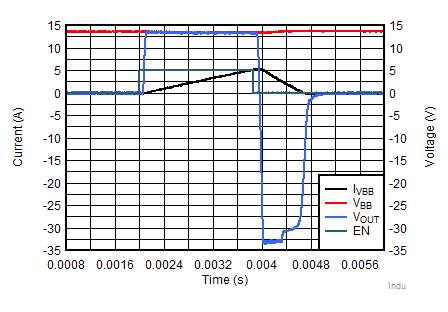ZHCSMM0 December 2020 TPS27SA08-Q1
PRODUCTION DATA
- 1 特性
- 2 应用
- 3 说明
- 4 Revision History
- 5 Device Summary Table
- 6 Pin Configuration and Functions
- 7 Specifications
- 8 Parameter Measurement Information
-
9 Detailed Description
- 9.1 Overview
- 9.2 Functional Block Diagram
- 9.3
Feature Description
- 9.3.1 Protection Mechanisms
- 9.3.2 Diagnostic Mechanisms
- 9.4 Device Functional Modes
- 10Application and Implementation
- 11Power Supply Recommendations
- 12Layout
- 13Device and Documentation Support
- 14Mechanical, Packaging, and Orderable Information
9.3.1.4.1 Driving Inductive and Capacitive Loads
When switching off an inductive load, the inductor may impose a negative voltage on the output of the switch. The TPS27SA08-Q1 device includes a voltage clamp to limit voltage across the FET. The maximum acceptable load inductance is a function of the device robustness. With a 5-mH load, the TPS27SA08-Q1 device can withstand a single pulse of 95 mJ inductive dissipation at 125°C and can withstand 56 mJ of inductive dissipation with a 10-Hz repetitive pulse. If the application parameters exceed this device limit, it is necessary to use a protection device like a freewheeling diode to dissipate the energy stored in the inductor. Figure 9-2 shows the TPS27SA08-Q1 device discharging a 5-mH load that is driven at 5 A.
 Figure 9-2 Inductive Discharge (5 mH, 5 A)
Figure 9-2 Inductive Discharge (5 mH, 5 A)In addition, the TPS27SA08-Q1 device current limit provides an ideal way to charge a capacitive load safely with limited inrush current. With no protection, charging a large capacitive load can lead to high inrush currents that pull a supply down, however by using a relatively low current limit value (regulation around 24 A), the capacitive load can be charged without impact to the power supply.
For more information on driving inductive or capacitive loads, reference TI's "How To Drive Inductive, Capacitive, and Lighting Loads with Smart High Side Switch application report.